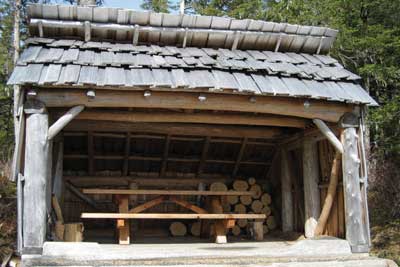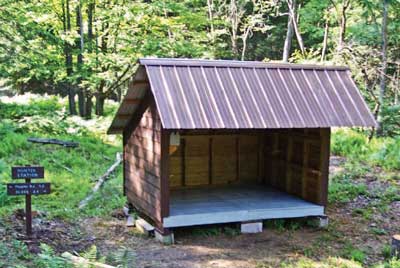Camp Shelters
Camp shelters are small structures typically enclosed on three sides with a roof or overhang. They are often located on trails. Figure 107 shows a typical camp shelter that provides some protection from the weather. Camp shelters aren't cabins. Cabins are typically fully enclosed and must comply with ABAAS, section 806 for transient lodging.

Figure 107—The entrance to the Three Lakes camp shelter at the Tongass National Forest is level with the ground.
Ensure that each camp shelter meets the following requirements, except in two circumstances. If a condition for an exception prohibits full compliance with a specific technical requirement in FSORAG, section 5.1, the camp shelter only has to comply with the specific requirement to the extent practicable. When more than two camp shelters are grouped together in a camping unit, only 20 percent of them (but never less than two) are required to meet the requirements. For example, if five camp shelters are grouped, 20 percent is one shelter. Because of the minimum number required, however, this group must include at least two shelters that meet the requirements. However, in a group of 15 shelters, 20 percent is 3 shelters. At the least, three shelters must meet the requirements. Remember that the requirements are minimums, and the Forest Service commitment to universal design dictates that as many shelters as is practicable should meet the requirements.
Connect camp shelters located on trails to the other constructed features at the site by a trail that meets the technical requirements in FSTAG. Connect camp shelters that are located in a campground and are not on a trail to other constructed features in the camping unit and to the common use features that are provided at the campground, such as toilets, showers, water hydrants, garbage receptacles, parking spaces, and beach access by an outdoor recreation access route.
Provide a clear floor or ground space at least 36 inches (915 millimeters) by 48 inches (1,220 millimeters) at the entrance to the camp shelter. The long side of the clear floor or ground space must be parallel to the camp shelter entrance. One full, unobstructed side of the clear ground space must adjoin or overlap the trail or outdoor recreation access route (as applicable) or another clear ground space. When a condition for an exception prohibits full compliance with the clear ground requirement, the clear ground space only has to comply to the extent practicable.
Ensure that the surface of the clear floor or ground space at the open entrance side of the shelter and the floor of the shelter is firm, stable, and does not slope more than 2 percent (1:48) in any direction. However, when the surface is unpaved or not built with boards, slopes 5 percent (1:20) or less are allowed if necessary for drainage.
When the floor at the entrance to the camp shelter is raised above the ground, ensure that the floor is 17 inches (430 millimeters) minimum to 19 inches (485 millimeters) maximum, higher than the adjoining clear space at the open entrance side (figure 108). This height must be maintained for a length of at least 48 inches (1,220 millimeters) beside the clear space so that someone using a wheelchair or other assistive device can transfer to the floor of the shelter.

Figure 108—The entrance to the Hunter Station camp shelter at the Allegheny National Forest is raised above the ground.
If the camp shelter has a level entry, provide a turning space that is 60 inches (1,525 millimeters) minimum in diameter (see figure 62) or is T-shaped with a minimum 60- by 36-inch (1,525- by 915-millimeter) arm and a minimum 36-inch (915-millimeter) -wide by 24-inch (610-millimeter) -long base (see figure 63) inside the camp shelter. This requirement is the same as ABAAS, section 304.3. The clear space and turning space allows someone using a wheelchair or other assistive device to approach and move about the camp shelter.
The floor surface within the camp shelter must be firm and stable and must not slope more than 2 percent (1:48) in any direction. If amenities such as tables or wood stoves are provided in camp shelters, they must meet the requirements of FSORAG, section 5.

User Comments/Questions
Add Comment/Question